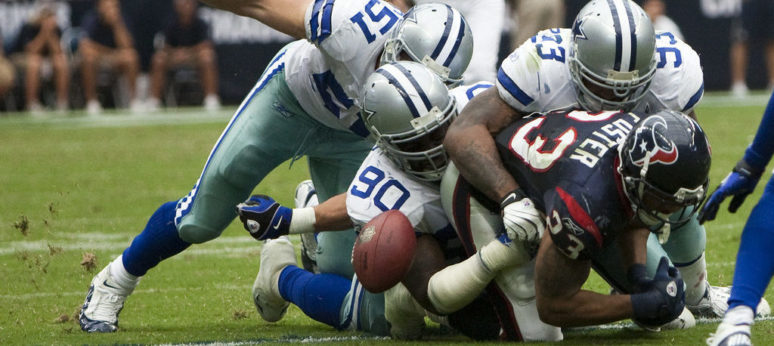It’s no secret. The team that wins the turnover battle greatly improves their chancing of winning. Despite this knowledge, it’s a stat that is often overlooked when handicapping the NFL.
If you can accurately predict who will win the turnover margin, you are going to have a very profitable season betting on the NFL. As you can see in the table below, teams don’t just win at an alarming rate, they also cover the spread.
How to Profit Handicapping NFL Turnover Differential
S.U. & ATS Records Based Off Turnover Margin Since 2005 (Regular-Season)
| TO Differential | SU | SU % | ATS | ATS % |
|---|---|---|---|---|
| +1 | 888-410-5 | 68.4% | 860-404-39 | 68.0% |
| +2 | 699-150 | 82.3% | 673-158-18 | 81.0% |
| +3 | 372-35-1 | 91.4% | 357-43-8 | 89.2% |
| +4 or more | 285-8-1 | 97.3% | 279-14-1 | 95.2% |
| TOTAL (+1 or better) | 2244-603-7 | 78.8% | 2169-619-66 | 77.8% |
The numbers really tell the story here. NFL teams cover the spread almost 69% (68.4%) of the time when they simply force one more turnover than the opposition. That should remove any doubt on whether you should be handicapping this when you are making your bets for the week.
I’m guessing there’s going to be a lot of you that say it’s too difficult to predict who will win the turnover battle on a game-to-game basis.
I’m not about to say luck isn’t involved. You can’t predict a bad bounce of the ball, there are multiple factors that go into turnovers. Some of which I think you can predict with some accuracy.
There are teams and schemes that excel in this department. No better example than the Patriots run here with Belichick and Brady. I went back just over the last 10 years and New England finished in the Top 15 in turnover margin every season.
Yes, the Patriots are in the minority when it comes to teams that consistently finish with a positive turnover margin. Few teams have a quarterback as gifted as Brady and a defensive mastermind as their head coach.
With that said, I think you can look at the make-up of each team in a given season and get a feel for how things could go in the turnover department.
Just don’t make this mistake. The general assumption for most amateur bettors is to look back on how a team did the previous season and go off of that. This wouldn’t be a bad strategy if teams didn’t undergo several personnel changes (players & coaches).
With the way the NFL is today it’s not a good idea to put any emphasis on the previous year. In fact, there’s a stronger possibility teams who thrived in the turnover department the prior year will regress the following season. At the same time, teams who struggled in this area tend to improve quite a bit over the next season.
What I found in my research is that the key is to focus on the offense and whether or not you think there’s a good possibility they will turn the ball over. Typically teams who have a smart experienced quarterback, a strong emphasis on ball security and a tenured offensive coordinator, are the teams that win the turnover battle on a regular basis.
A lot of attention is payed to defenses and their ability to force turnovers, but a lot of luck is involved when it comes to creating turnovers.
There are quarterback’s like Alex Smith who is the definition of a game-manager. A quarterback who isn’t going to put his defense in a bad spot by throwing an interception. At the same time, Smith has played on teams that have had excellent defenses. It’s why in a league dominated by elite quarterbacks with big arms, a signal caller like Smith can post a 94-66-1 record as a starter (58.8%). Note that 59% is right in the middle of the winning percentage of a 9 or 10 win team.
Looking back over the last 12 years, only two teams that finished in the top three in turnover differential the previous year went on to finish with a stronger turnover differential the next season. That was the 2012 New England Patriots and 2016 Kansas City Chiefs. Of the teams who have finished in the bottom three, only twice has a team finished with a worse turnover margin the next year (2012 Eagles & 2007 49ers).
What’s really stands out is how the regression on both sides has a big impact on the overall record of a team the next season. Rarely will a team finish in the Top 5 and improve on their win total the next season. Same thing with teams who finish at the bottom. Chances are they will win more games the following year.
While looking at the previous season might not help us predict who will win the turnover battle for a particular game the next year, it’s a great tool to use for making your win total predictions. Here’s a look at the top and bottom five teams on each side of the turnover differential from 2018.
2018: Best/Worst Turnover Margins
Top 5
- Seahawks +15
- Texans +13
- Bears +12
- Rams +11
- Patriots +10
Bottom 5
- 49ers -25
- Bucs -18
- Jaguars -12
- Cardinals -12
- Steelers -11
Using Last Year’s Turnover Differential to Handicap NFL Win Totals
Every year teams will defy the turnover statistic. Some teams are able to post a winning record with a negative turnover differential and vice versa.
I got to thinking about how this might be a key to which direction a team is headed. My hypothesis was that teams who were able to finish with a winning record despite a negative turnover margin were inclined to struggle the next season, while teams who thrived in the turnover department and ended up with a losing record would see a bump in their win total the next year.
Keep in mind that win totals are often set based on last year’s record, so we should be able to find some value in betting NFL win totals. Here’s a look at the results of both scenarios and how teams have responded the next year.
Losing Record & (+) Turnover Differential
| Year | Team | Record | TOD | Next Year Record | Net Wins/Losses |
|---|---|---|---|---|---|
| 2007 | Panthers | 7-9 | +1 | 12-4 | +5 |
| 2007 | Broncos | 7-9 | +1 | 8-8 | +1 |
| 2007 | Falcons | 4-12 | +4 | 11-5 | +7 |
| 2007 | Bengals | 7-9 | +5 | 4-12 | -3 |
| 2007 | Bills | 7-9 | +9 | 7-9 | EVEN |
| 2008 | Raiders | 5-11 | +1 | 5-11 | EVEN |
| 2008 | Browns | 4-12 | +5 | 5-11 | +1 |
| 2008 | Chiefs | 2-14 | +5 | 4-12 | +2 |
| 2008 | Packers | 6-10 | +7 | 11-5 | +5 |
| 2009 | Chiefs | 4-12 | +1 | 10-6 | +6 |
| 2009 | Jaguars | 7-9 | +2 | 8-8 | +1 |
| 2009 | Bills | 6-10 | +3 | 4-12 | -2 |
| 2010 | Lions | 6-10 | +4 | 10-6 | +4 |
| 2010 | Rams | 7-9 | +5 | 2-14 | -5 |
| 2011 | Bills | 6-10 | +1 | 6-10 | EVEN |
| 2011 | Panthers | 6-10 | +1 | 7-9 | +1 |
| 2011 | Seahawks | 7-9 | +8 | 11-5 | +4 |
| 2011 | Jaguars | 5-11 | +5 | 2-14 | -3 |
| 2011 | Browns | 4-12 | +1 | 5-11 | +1 |
| 2012 | Browns | 5-11 | +3 | 4-12 | -1 |
| 2012 | Bucs | 7-9 | +3 | 4-12 | -3 |
| 2012 | Saints | 7-9 | +2 | 11-5 | +4 |
| 2012 | Chargers | 7-9 | +2 | 9-7 | +2 |
| 2012 | Panthers | 7-9 | +1 | 12-4 | +5 |
| 2013 | Bucs | 4-12 | +10 | 2-14 | -2 |
| 2013 | Rams | 7-9 | +8 | 6-10 | -1 |
| 2013 | Bills | 6-10 | +3 | 9-7 | +3 |
| 2014 | Browns | 7-9 | +6 | 3-13 | -6 |
| 2014 | Falcons | 6-10 | +5 | 8-8 | +2 |
| 2014 | Panthers | 7-8-1 | +3 | 15-1 | +8 |
| 2015 | Giants | 6-10 | +7 | 11-5 | +5 |
| 2015 | Rams | 7-9 | +5 | 4-12 | -3 |
| 2015 | Saints | 7-9 | +2 | 7-9 | EVEN |
| 2015 | Raiders | 7-9 | +1 | 12-4 | +5 |
| 2016 | Bills | 7-9 | +6 | 9-7 | +2 |
| 2016 | Eagles | 7-9 | +6 | 13-3 | +6 |
| 2016 | Bengals | 6-9-1 | +3 | 7-9 | +1 |
| 2017 | Colts | 4-12 | +5 | 10-6 | +6 |
| 2018 | Browns | 7-8-1 | +7 | TBD | TBD |
| 2018 | Broncos | 6-10 | +7 | TBD | TBD |
| 2018 | Redskins | 7-9 | +7 | TBD | TBD |
| 2018 | Dolphins | 7-9 | +5 | TBD | TBD |
| 2018 | Giants | 5-11 | +2 | TBD | TBD |
| 2018 | Falcons | 7-9 | +1 | TBD | TBD |
| 2018 | Bengals | 6-10 | +1 | TBD | TBD |
| 2018 | Panthers | 7-9 | +1 | TBD | TBD |
The numbers agree with us. We have 38 examples of teams who have posted a losing record with a positive turnover margin. Out of the 38 occurrences, 28 times (74%) the team went on to post the same or better record than the previous year.
Last year the only candidate on the board was the Indianapolis Colts. All they did was go 10-6 after a 4-12 mark in 2016 for a net +6 in wins. If you like what you see, there’s a ton of option in play for 2019 (8 different teams qualify).
Winning Record & (-) Turnover Differential
| Year | Team | Record | TOD | Next Year Record | Net Wins/Losses |
|---|---|---|---|---|---|
| 2007 | Giants | 10-6 | -9 | 12-4 | +2 |
| 2007 | Redskins | 9-7 | -5 | 8-8 | -1 |
| 2007 | Browns | 10-6 | -2 | 4-12 | -6 |
| 2008 | Cowboys | 9-7 | -11 | 11-5 | +2 |
| 2008 | Vikings | 10-6 | -6 | 12-4 | +2 |
| 2008 | Falcons | 11-5 | -3 | 9-7 | -2 |
| 2008 | Jets | 9-7 | -1 | 9-7 | EVEN |
| 2009 | Cardinals | 10-6 | -7 | 5-11 | -5 |
| 2009 | Steelers | 9-7 | -4 | 12-4 | +3 |
| 2009 | Texans | 9-7 | -1 | 6-10 | -3 |
| 2010 | Colts | 10-6 | -4 | 2-14 | -8 |
| 2010 | Giants | 10-6 | -3 | 9-7 | -1 |
| 2011 | Steelers | 12-4 | -13 | 8-8 | -4 |
| 2011 | Saints | 13-3 | -6 | 7-9 | -6 |
| 2012 | Broncos | 13-3 | -1 | 13-3 | EVEN |
| 2012 | Vikings | 12-4 | -1 | 5-10-1 | -7 |
| 2012 | Colts | 11-5 | -12 | 11-5 | EVEN |
| 2013 | Cardinals | 10-6 | -1 | 11-5 | +1 |
| 2013 | Packers | 8-7-1 | -3 | 12-4 | +4 |
| 2013 | Chargers | 9-7 | -4 | 9-7 | EVEN |
| 2014 | Chiefs | 9-7 | -3 | 11-5 | +2 |
| 2014 | Colts | 11-5 | -5 | 8-8 | -3 |
| 2014 | Chargers | 9-7 | -5 | 4-12 | -5 |
| 2014 | Eagles | 10-6 | -8 | 7-9 | -3 |
| 2015 | Broncos | 12-4 | -4 | 9-7 | -3 |
| 2016 | Lions | 9-7 | -1 | 9-7 | EVEN |
| 2016 | Giants | 11-5 | -2 | 3-13 | -8 |
| 2016 | Texans | 9-7 | -7 | 4-12 | -5 |
| 2017 | Cowboys | 9-7 | -1 | 10-6 | +1 |
| 2017 | Panthers | 11-5 | -1 | 7-9 | -4 |
| 2017 | Falcons | 9-7 | -2 | 7-9 | -2 |
| 2017 | Titans | 9-7 | -4 | 9-7 | EVEN |
| 2018 | Titans | 9-7 | -1 | TBD | TBD |
| 2018 | Ravens | 10-6 | -3 | TBD | TBD |
| 2018 | Steelers | 9-6-1 | -11 | TBD | TBD |
As we expected, teams who finish with a winning record and negative turnover differential are more likely to fail to match the previous year’s success. As you can see it doesn’t happen as frequently. There have been just 35 times that a team fell in this spot. Out of the 35, there have been 24 times (68.6%) that a team finished with the same or worse record.
We have three candidates to look at for 2019 in the Titans (second year in a row), Ravens and Steelers. Based on the percentages at least 2 of these 3 teams will finish with a worse record.


